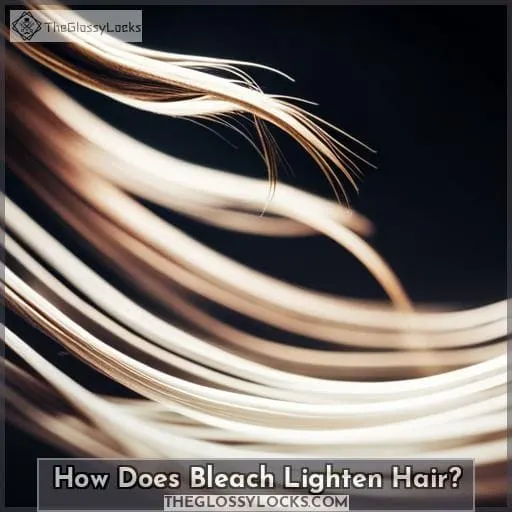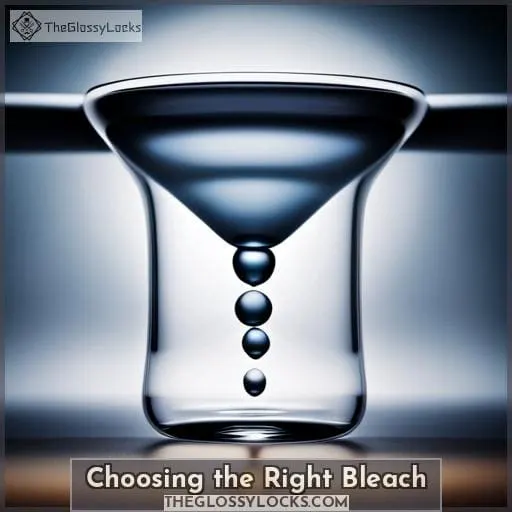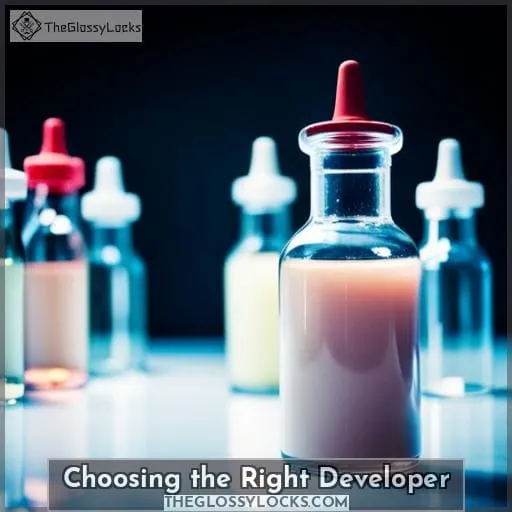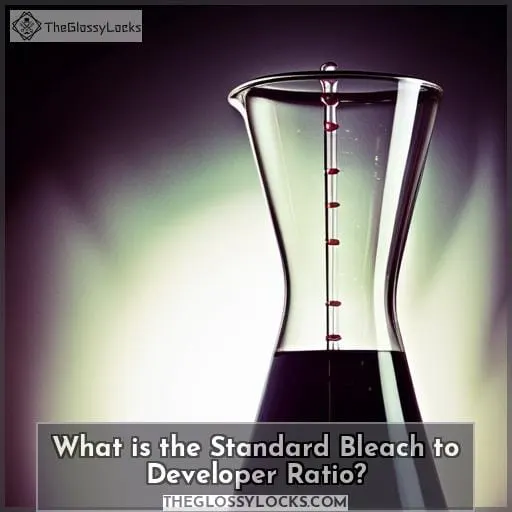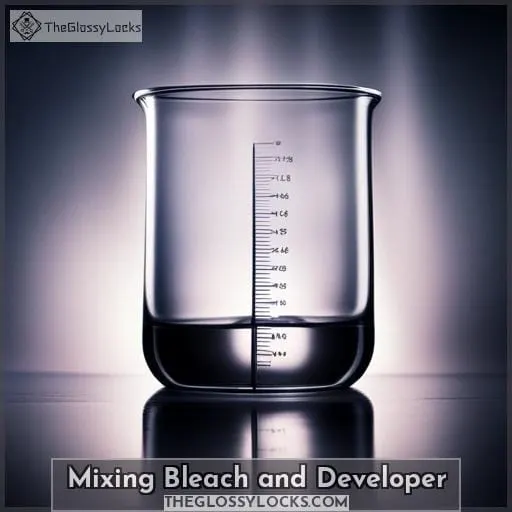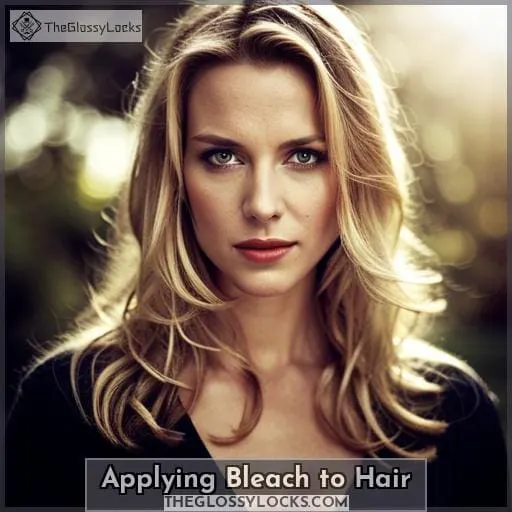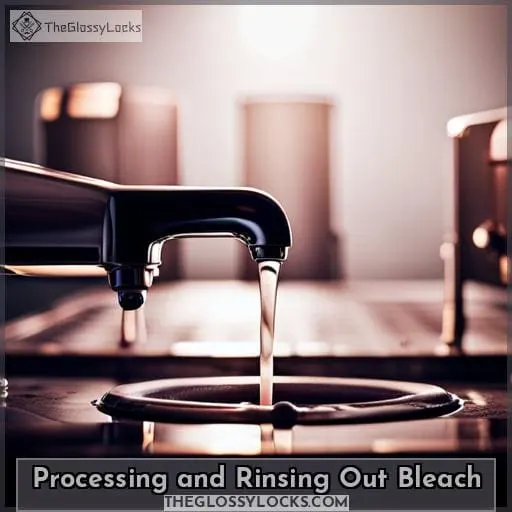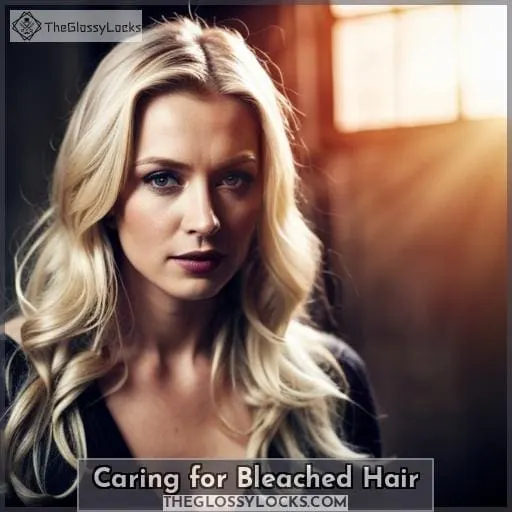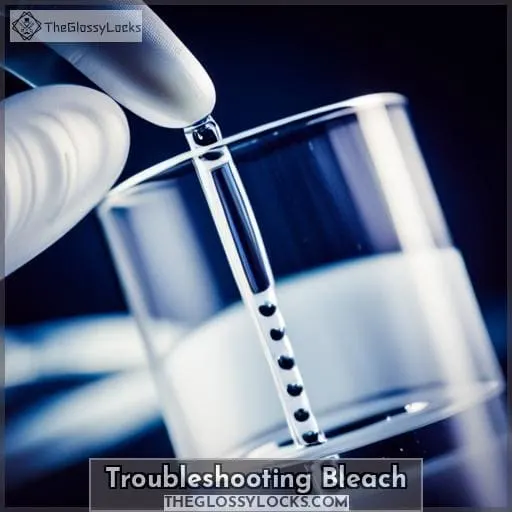This site is supported by our readers. We may earn a commission, at no cost to you, if you purchase through links.

Let’s walk through this hand-in-hand. First, choose your bleach wisely. Aim for gentle formulations with built-in protectants. Scalp sensitivity? Opt for lower volumes. For optimal lift on darker hair, select a higher volume developer.
Now, the ratio. Generally, mix equal parts bleach and developer. But you can tweak this depending on your goals.
Ultimately, monitor hair closely during processing. And don’t push it too far too fast.
See, you’ve got this! Together, we’ll get your hair the perfect blonde.
Table Of Contents
- Key Takeaways
- How Does Bleach Lighten Hair?
- Choosing the Right Bleach
- Choosing the Right Developer
- What is the Standard Bleach to Developer Ratio?
- When to Adjust the Ratio
- Mixing Bleach and Developer
- Applying Bleach to Hair
- Processing and Rinsing Out Bleach
- Caring for Bleached Hair
- Troubleshooting Bleach
- Conclusion
Key Takeaways
- The standard ratio of bleach to developer is 1:2 for most applications.
- Adjusting the ratio allows you to customize the lightening speed. More developer speeds up the lightening process.
- Using less developer leads to a more gradual lightening effect.
- Mastering the ideal ratio for your specific hair type helps achieve your desired shade safely and effectively.
How Does Bleach Lighten Hair?
You activate bleaching agents and open stubborn cuticles when you mix bleach and developer, blondie. The bleach powder contains persulfates like ammonium, sodium, and potassium that break apart hair’s melanin molecules.
When combined with hydrogen peroxide in the developer, an oxidizing reaction occurs that decolorizes the pigment. The bleach’s alkalinity also swells and lifts the cuticle layers so pigment can escape.
More developer means quicker and higher lifting of underlying warm tones until you hit platinum. But don’t overdo it! Keeping the proper ratio of bleach powder to developer allows for safe, even lightening.
Remember, your ends get more chemical exposure so they lighten first. Follow the instructions and use your common sense.
Choosing the Right Bleach
Finding the right bleach to developer ratio is crucial for minimizing hair color damage, as rough and coarse hair can be a sign that your locks are crying out for some TLC with hair color damage repair tips. Finding the right bleach to developer ratio is crucial for getting the hair color results you want without damage. For scalp bleaching, opt for a 1:2 ratio of bleach powder to developer like Quick Blue with 20 volume Wella developer to gently lift dark hair.
While for faster lightening on mid-length and ends, increase to a 2:1 ratio using 30 volume cream developer from Super Star.
For Scalp
When bleaching your scalp, be extra careful by doing a patch test first and keeping the mixture at least 1/8 inch away to avoid irritation. Some recommended bleaches for on-scalp application are Brilliant Blondexx and Wella Blondor, which contain lower ammonia and special polymers to reduce scalp sensitivity.
Always do a strand test to determine the right developer volume and processing time.
For scalps prone to irritation, stay on the cautious side with a 1:2 bleach to developer ratio.
Limiting contact with the scalp and using a quality bleaching product will achieve beautiful blonde results without causing damage.
For Dark Hair
Since dark hair requires more lifting power, go for a higher bleach to developer ratio like 1:1 or 2:1. For dark hair, use 30 volume cream developer at a 1:1 or 2:1 ratio with blue bleach powder. Apply with a tint brush 1/8 inch from the scalp. Process for 30-45 minutes based on hair porosity, checking every 10 minutes.
Rinse thoroughly, then apply toner to neutralize orange tones. Deep condition and limit washing to retain moisture in bleached hair.
Choosing the Right Developer
When bleaching your hair at home, it’s essential to consider the developer strength, as higher percentages offer more lift but can also cause more damage, especially if you’re new to bleaching at home safely. When bleaching your hair at home, the ratio of bleach powder to developer is crucial for safe, effective lightening. To speed up the lightening process while minimizing damage, increase the developer amount from the standard 1:2 ratio up to 1:1.
This activates the bleach quickly for vibrant results while still being cautious enough to avoid breakage.
Standard Bleach to Developer Ratio
The tried and true bleach to developer ratio begins at 1:2 for most techniques. This standard mixture provides a balanced lightening speed without risking damage. Start with one part bleach powder and two parts developer in your non-metallic bowl.
Mix to a smooth, pudding-like consistency. For lighter blondes, increase the ratio to 1:1n5. For darker shades, use 1:3. Remember, too much developer dilutes the bleach and slows lifting. Adjust your ratio based on the hair’s natural level and your desired color. And always do a strand test first.
– Increasing Developer for Faster Lightening
To lighten hair more quickly, increase the bleach powder to developer ratio, such as going to 2:1. For faster lightening, boost the developer volume or percentage as per the instructions. This intensifies the chemical reaction that lifts pigment. However, bleach strength also matters; weaker bleach requires more developer.
Carefully perform strand tests to determine the ideal ratio for your hair type. Avoid overdoing it though – hair still requires moisture. Trimming helps minimize damage from frequent bleaching. The optimal developer ratio is key for balancing vibrant color and healthy hair.
– Lowering Developer to Avoid Damage
Friend, why daydream of Rapunzel when your straw-like hair screams Snow White post-poisoned apple? Rather than frying your locks, gently coax out your inner blonde with a lower bleach ratio. When lightening hair, a lower developer provides a gentler lift to preserve integrity.
Slow, steady activation allows for even tone without overprocessing. Adjust your bleach-to-developer ratio based on your hair’s current state. For compromised strands, dilute the mixture to limit damage. With thoughtful formulation, you can achieve luminous locks without compromise.
Trust the chemical reaction and respect your hair’s needs. A thoughtful approach allows you to unlock vibrant color while maintaining healthy hair.
What is the Standard Bleach to Developer Ratio?
You gotta start with a 1:2 bleach-to-developer ratio for even lifting and minimal damage. The standard ratio provides a good balance of lightening power and protection. As a chemical reaction, bleach breaks bonds while developer opens the cuticle for results.
Your supplies kit needs gloves, a bowl, and a brush. The standard 1:2 ratio keeps the mixture fluid and spreadable. Thinner bleach risks hot roots and splotches if ratios lean too high. Saturate every strand, part hair cleanly.
Lift dark hair incrementally – don’t rush to platinum. Rinse, tone, and moisture mask immediately after.
When to Adjust the Ratio
When lightening hair quickly is the goal, increase the ratio of bleach powder to developer, such as using a 2:1 ratio. For a slower, gentler lightening process that helps avoid damage, decrease the ratio like using a 1:2 bleach to developer ratio.
For Faster Lightening
To quickly lighten locks, lift the level lavishly. Adjusting the ratio of bleach to developer is a tried-and-true technique for lightning-fast lightening. Ramp up the developer strength for speedier brightening, taking care to protect locks with nourishing conditioners.
When color correcting requires a higher ratio like 2:1, handle hair gently, rinsing thoroughly. Respect the reactive relationship, keeping safety first when pushing lightness limits.
For Gentler Lightening
If lightening your hair gradually suits your needs, decreasing the bleach-to-developer ratio can make the process less harsh. Use a lower volume developer, like 10 or 20 volume, to slowly lift pigment over multiple sessions.
Consider using less concentrated bleach powder if you want a gentler routine. Prioritize hair health with a 1:2 bleach-to-developer ratio and focus on balayage techniques. Assess hair condition regularly and adjust your approach to avoid breakage. A gradual lightening process with a lower developer is an ideal way to minimize damage.
Mixing Bleach and Developer
Measure the bleach and developer carefully before mixing them together thoroughly until you achieve a smooth, creamy consistency resembling gravy. When home bleaching, always start with clean, dry hair and use gloves to avoid irritation.
Mix the bleach powder and developer in a non-metallic bowl at a 1:2 ratio. Stir continuously with a tinting brush or whisk to fully incorporate the products. The mixture should resemble a thick, smooth cream with no lumps. Avoid splashing or dripping for maximum control.
Monitor the consistency during application in case it needs slight adjustment. With the right ratios and mixing techniques, you’ll get beautiful, evenly lifted blonde hair.
- Use room temperature water if thinning the bleach mixture
- Increase ratio for stronger bleach or lighter results
- Don’t exceed 1:2 bleach to developer ratio
- Add developer to bleach powder while stirring
Applying Bleach to Hair
Your hair awaits a brilliant transformation once you evenly coat each strand with the prepared lightening mixture. With proper sectioning, you can methodically saturate your tresses from root to end. Work swiftly, yet cautiously, through each lock to achieve uniform lightening. Monitor the clock and rinse thoroughly once optimal processing time is reached.
Avoid overlapping lightened pieces to prevent hot spots. Correct any uneven tones by carefully applying bleach just to the darker sections.
| Section Hair | Apply Bleach Mix |
|---|---|
| Front hairline | Root to ends |
| Crown | Root to ends |
| Left side | Root to ends |
| Right side | Root to ends |
| Nape of neck | Root to ends |
Processing and Rinsing Out Bleach
After scrubbing your scalp and applying shampoo, rinse the bleach-coated strands for 5-7 minutes under warm water to fully remove product and avoid post-bleaching breakage, which makes up 67% of salon chemical service complaints.
Continue rinsing until water runs clear to effectively neutralize remaining bleach residue. Mix equal parts blue or purple toner with volume 10 developer; apply to towel-dried hair for 3-5 minutes to cancel out brassy tones.
Rinse thoroughly again. Avoid rubbing hair roughly with towels; gently squeeze out excess moisture then allow hair to air dry to prevent damage to fragile strands. Daily treatments with hydrating masks reinforce and smooth the hair cuticle. When styling fragile bleached hair, always use heat tools below 300°F with heat protectant to minimize breakage.
The correct bleach ratio and gentle handling preserves your bright, beautiful color.
Caring for Bleached Hair
When bleaching your hair at home, it’s crucial to properly care for your strands post-lightening. Be sure to regularly use a hydrating deep conditioner and always apply a heat protectant before exposing your hair to heat styling tools, as brittle, bleached hair is prone to further damage without the extra conditioning and heat protection.
Varying your sentence structure and length will help your writing sound more natural.
Conditioning
Keep her conditioned after you bleach, honey. Deep conditioning restores moisture to those fragile, bleached locks. Use a reparative mask weekly, leaving it on for at least 10 minutes. Alternate between protein-packed treatments and hydrating moisture masks.
Nourish those thirsty strands back to health. A good conditioner helps maintain that pretty color too. Just don’t overdo the protein or it’ll make your hair brittle. Focus on replenishing moisture after all that bleaching.
Heat Protection
Nourish those fragile bleached tresses by cocooning them in a heat protectant serum before taking hot tools to task, lest you singe your precious hair into a crispy, straw-like mess. Safeguarding your bleached hair from heat damage requires diligent prep work. Before curling or straightening, apply a heat protectant to form an insulating barrier.
Seek out lightweight serums with both moisturizing and thermal defense properties.
Regular conditioning treatments further bolster hair’s resilience. With prudent product selection and conscientious heat habits, you’ll maintain your brightened bouffant in optimal health.
Troubleshooting Bleach
When bleaching hair, an improper ratio of bleach to developer is a common cause of unwanted results like breakage or brassiness. To avoid this, carefully follow the instructions for mixing your specific bleach and developer, as the ideal ratio can vary.
Generally a 1:2 or 1:1 ratio is recommended, but weaker bleach may require more developer while very resistant hair needs a higher concentration of bleach. You should test a strand first and closely monitor processing time to determine the optimal bleach-to-developer balance for your hair.
Breakage
You must promptly trim any broken sections to avoid further splitting.
- Analyze hair integrity after rinsing bleach.
- Look for split or broken strands, especially near ends.
- Carefully snip split strands above the breakage point.
- Follow with a deep conditioning treatment.
- Schedule regular trims every 6-8 weeks.
Preventing breakage involves maintaining the structural integrity of hair strands. First, assess hair after bleaching for any broken sections that require trimming. Then, deep condition and continue moisturizing to combat dryness from chemicals.
Lastly, get frequent trims to remove damaged ends before they split up the hair shaft.
Brassiness
Fine hair gets brassy fast so watch those yellow tones. Use purple shampoo weekly to eliminate brassy yellow and orange tones. Invest in specialized toning and color correction products for yellow-free hair care.
Closely monitor the root area and re-tone at the first signs of brassiness. Consistent toning maintains your desired shade for longer between full coloring services.
Conclusion
Achieving perfect lightened hair without damage takes finesse, like a chemist carefully calculating ingredients for a formula. The magic lies in the bleach-to-developer ratio. Increasing the developer speeds up lightening, while decreasing it gently brightens.
Whether subtly highlighting sun-kissed strands or pursuing platinum blonde, mastering the mixture allows you to reach your ideal shade. With the proper bleach-to-developer ratio, you can safely lighten locks to the exact hue you’ve dreamed of.

